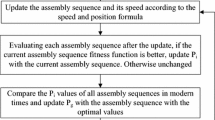Abstract
The demands on assembly accuracy require accurate operations both in machining and assembly in order to achieve the high performance of products. Although advanced machining technologies can be used to satisfy most of the demands on precision assembly, the corresponding manufacturing cost will also be increased. Selective assembly provides an effective way for producing high-precision assembly from relatively low-precision components. The accuracy of selective assembly is mainly based on the number of groups and the range of the group (allocated equally on the design tolerance). However, there are often surplus parts in some groups due to the imbalance of mating parts, especially in the cases of undesired dimensional distributions, which makes the methods developed and reported in the literature often not suitable for practice. In this work, a particle swarm optimization (PSO) algorithm is proposed by applying batch selective assembly method to a complex assembly with three mating components (as in ball bearing: an inner race, ball and outer race), to minimize the surplus parts and thereby maximizing the assembly efficiency. Due to the continuous nature of particle swarm optimization algorithm, standard PSO equations cannot be used to generate discrete combination of mating parts. An effective encoding scheme is developed to make the combination of mating parts feasible. The evolution performance of the PSO algorithm with different control parameter values is also analysed.
Similar content being viewed by others
References
Fang XD, Zhang Y (1995) A new algorithm for minimizing the surplus parts in selective assembly. Comput Ind Eng 28:341–350
Chan KC, Linn RJ (1998) A grou** method for selective assembly of parts of dissimilar distributions. Qual Eng 11(2):221–234
Kannan SM, Jayabalan V (2001) A new grou** method for minimizing the surplus parts in selective assembly. Qual Eng 14(1):67–75
Kern DC (2003) Forecasting manufacturing variation using historical process capability data: application for random assembly and serial processing. Dissertation, Massachusetts Institute of Technology, pp 137–188
Chen M-S (1996) Optimising tolerance allocation for mechanical components correlated by selective assembly. Int J Adv Manuf Technol 12:349–355
Mease D, Sudjianto A, Nair VN (2004) Selective assembly in manufacturing: statistical issues and optimal binning strategies. Technometrics 46(2):165–175
Kannan SM, Asha A, Jayabalan V (2005) A new method in selective assembly to minimize clearance variation for a radial assembly using genetic algorithm. Qual Eng 17:595–607
Stoll HW (1999) Product design methods and practices. CRC Press, Boca Raton, USA
Wang Y (2008) Semantic tolerance modelling with generalized intervals. J Mech Des. doi:10.1115/1.2936900, Volume 130, Issue 8, 7 pages
Fu**o Y (1987) Matching problem when lot size is large. Reports of Statistical Application Research 34:1–10
Shan HS, Satyawadi A (1989) Computer-aided component selection for precision assembling. 10th international conference on production research, University of Nottingham, UK, pp. 734–739
Coullard CR, Gamble AB, Jones PC (1998) Matching problems in selective assembly operations. Ann Oper Res 76:95–107
Akachai Jantayavichit (2000) Efficient algorithms for tolerance improvement through selective assembly. Ph.D. thesis, University of Wisconsin-Madison, pp 128–160
Kannan SM, Sivasubramanian R, Jayabalan V (2008) Particle swarm optimization for minimizing assembly variation in selective assembly. Int J Adv Manuf Technol 42:793–803
Parrish A (1973) Mechanical engineer's reference book. Butterworths, London
Osma A (2009) A statistical approach to comparing whell hub forging processes. Proc Int Mech Eng Part D, Journal of Automobile Engineering 223:1559–1576
Lind DA, Marchal WG, Wathen SA (2005) Statistical techniques in business and economics, 12th edn. McGraw-Hill Irwin, New York
Kennedy J, Eberhart RC (1995) Particle swarm optimization. Proceedings of the IEEE International Conference on Neural Networks, Perth, Australia, pp 1942–1948
Shi YH, Eberhart RC (1998) A modified particle swarm optimizer. IEEE International Conference on Evolutionary Computation, Anchorage, Alaska, 4–9 May 1998
Shi YH, Eberhart RC (1998) Parameter selection in particle swarm optimization. 1998 Annual Conference on Evolutionary Programming, San Diego
Eberhart RC, Shi YH (1998) Comparison between genetic algorithm and particle swarm optimization. 1998 Annual Conference on Evolutionary Programming, San Diego
Chen YM, Lin CT (2007) A particle swarm optimization approach to optimize component placement in printed circuit board assembly. Int J Adv Manuf Technol 35:610–620
Lv H, Lu C (2010) An assembly sequence planning approach with a discrete particle swarm optimization algorithm. Int J Adv Manuf Technol 50:761–770
Liu B, Wang L, ** YH (2007) An effective hybrid particle swarm optimization for no-wait flow shop scheduling. Int J Adv Manuf Technol 31:1001–1011
Author information
Authors and Affiliations
Corresponding author
Rights and permissions
About this article
Cite this article
Raj, M.V., Sankar, S.S. & Ponnambalam, S.G. Particle swarm optimization algorithm to maximize assembly efficiency. Int J Adv Manuf Technol 59, 719–736 (2012). https://doi.org/10.1007/s00170-011-3512-2
Received:
Accepted:
Published:
Issue Date:
DOI: https://doi.org/10.1007/s00170-011-3512-2




